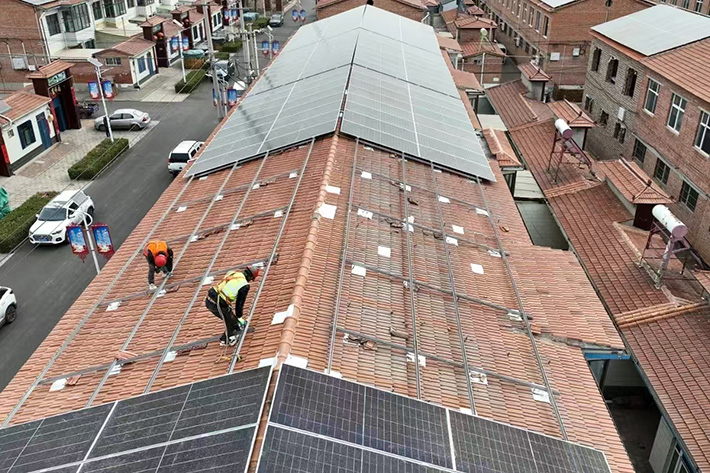|
||||||||||
| Home Top News Economy/Tech Culture/Sports China in Foreign Eyes Green Development Videos Intangible Cultural Heritages |
|
||||||||||
| Home Top News Economy/Tech Culture/Sports China in Foreign Eyes Green Development Videos Intangible Cultural Heritages |
| ChinAfrica |
| Solar Power Goes Online |
| In a village in Shanxi, solar electricity is feeding into the grid thanks to an innovative technique |
| By Ge Lijun | VOL. 17 July 2025 ·2025-07-16 |

Workers install photovoltaic panels on rooftops in Nanzhanghe Village, Zhangzi District, Changzhi, Shanxi Province (CHANGZHI DAILY)
In Nanzhanghe Village, located in Zhangzi District, Changzhi, Shanxi Province, rows of brand-new solar panels glisten under the sun. The electricity they produce is collected by a new network, then steadily injected into a 10 kV power line after the voltage is increased. This process relies on an innovative model known as “centralised collection and connection after voltage elevation,” piloted by the State Grid Shanxi Electric Power Co.
By the end of 2024, distributed photovoltaic installations in Changzhi had achieved a total grid-connected capacity of 690,000 kW. Of that, 332,100 kW were added during the year, representing a 139 percent increase over 2023 and setting a new record. However, the rapid expansion is placing increasing strain on rural power networks, which still face capacity limitations.
This challenge is evident in Nanzhanghe, home to 58 households and equipped with a 200 kVA transformer. Under the standard low-voltage connection model, the village can feed no more than 160 kW into the grid - enough to accommodate the output of only eight households. This falls well short of what is needed to connect the entire village.
After thorough research, the local branch of State Grid in Zhangzi District proposed a new model called “centralised collection and connection after voltage elevation.” Under this system, photovoltaic companies take responsibility for building a low-voltage collection network, installing a transformer to increase voltage, laying connection lines, and integrating a control terminal. As a result, the electricity produced is directly transformed to 10 kV before being fed into the rural grid.
The pilot project is being implemented in two phases. The first phase covers 17 households with an installed capacity of 320 kW and includes the installation of a 400 kVA transformer, which successfully came into service on 7 January. The second phase, currently underway, aims to equip all village rooftops. Once complete, the total installed capacity will reach 1.2 mW.
According to Wang Jianjun, head of the Zhangzi District electricity company, this model effectively overcomes the limitations of existing transformers. It enables the scaling up of photovoltaics, allowing the village to move from kilowatt to megawatt capacity. The shift from multi-point to single-point connection also simplifies centralised management and paves the way for smoother participation in the electricity market.
Residents are already seeing tangible benefits. Each household has signed a 25-year rooftop lease agreement with the companies. In addition to an installation bonus of 10,800 yuan ($1,503), they receive annual rent exceeding 2,100 yuan ($292), providing a supplementary source of income, all without leaving their homes.
| About Us | Contact Us | Advertise with Us | Subscribe |
| Copyright Beijing Review All rights reserved 京ICP备08005356号-5 京公网安备110102005860号 |